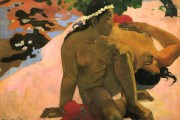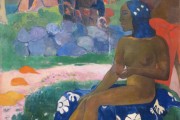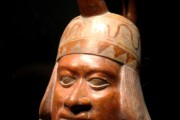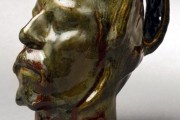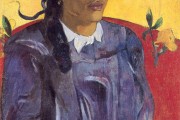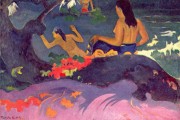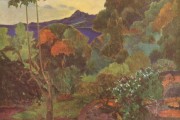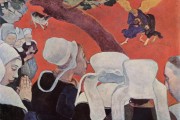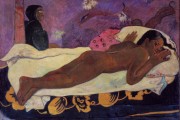
Paul Gauguin, cursed artist, misunderstood by society for his radical and non-conformist choices. A life marked by the constant need to escape from a world, the West, which he gets to know thanks to a comfortable bourgeois lifestyle that he experiences with his wife, family and property. His is a free spirit looking for a wild and primitive life that will take him away from modern civilization and will lead him to unknown and uncontaminated lands in contact with primitive art, a regenerative source for many artists. Art will then become an absolute center of force for his existence. The message that he is so determined to give to future generations is the entitlement to freedom in art, the “right to dare everything” and the belief that the success of an artist does not depend on the consent of the public. The first contact with primitive culture that Gauguin has is when he was a child: his father, a journalist of Republican ideas, was forced to leave Paris for Peru because of his opposing ideas, where part of the family of his wife was. The memories of the Inca ceramics, which were of powerful expressive power and simplicity, leave their mark in the memory of little Paul. The artist will develop the desire to explore new lands when he is just 17 years old, when he decides to embark as a sailor in the merchant marine and for more than five years will travel around by sea. After this he will work for an exchange agency; the finance sector was booming and Gauguin will maintain a middle-class standard of living. He approaches art initially as a collector of Impressionist works, but begins to paint in his free time taking inspiration from the Impressionist style. The turning point comes when a major crisis across the stock exchange market forces brokers to reduce staff. Gauguin looses his job: what was initially perceived as a misfortune becomes the event that marks the path of the full expression of the spirit of the artist. Gauguin thought he could finance his life with painting but the crisis in the family relationships was forthcoming when Mette, his Danish wife, understands that he won’t be able to ensure the same comfortable bourgeois lifestyle they have been enjoying up to that point.
The family of his wife will ostracize him. As a result of this crisis, the artist decides to move to Pont Aven in Brittany, a country that had still retained the integrity of their tradition without having been infected by the myth of progress, individualism and by the ugliness of modern society. Here he works with the aim of finding the roots of humanity, reflecting people’s identity in his canvases. The School of Pont Aven will be founded, of which also Emile Bernard was part.
In this period one of his masterpieces was born “Vision after the Sermon”, manifesto of Symbolism. A way of painting without modeled and shadows, based on simplified forms and surrounded by a dark line filled with flat and anti-naturalistic fields of color was created, reminiscent of Japanese prints, known in France thanks to the Universal Exposition.
Symbolism was based on the teaching of Baudelaire, according to which imagination appeared to be the queen of all faculties. Bernand taught to Gauguin “not to paint too much from the truth. Art is abstraction”. These lessons are being drawn by primitive art that starts from the spirit and makes use of nature, allowing a return to the Principle, that is the goal of Symbolism. The artist will then decide to continue his journey in a place isolated from the world to unwind. He chooses the island of Martinique, where he will state: “Here there is every possible element to be happy: the sea, the coconut trees, fruit trees of each type, a rich nature, a warm climate…”. The tropical landscapes are typical of this period, that show a wild and lush nature, a harsh light that he represents with bright and vivid colors. But the artist’s trips do not end here. Theo, Van Gogh ‘s brother, will invite him to cohabit with Vincent for a certain period in order to create a town of artists that will allow a new form of art, Van Gogh’s utopia. To convince Gauguin, Theo promises to sell his paintings. Paul accepts, thinking that the money he will earn could finally allow his dream journey to the islands of French Polynesia. Gauguin affirms in memory of that period: “Van Gogh is a romantic while I prefer what is primitive. In terms of color he likes the randomness of the dough, while I hate messy finishes”. Following the detachment with his friend, who will bring Van Gogh to total madness, the spirit of Gauguin is not yet sated with adventures, as he chooses to travel to the tropical paradise of Tahiti, after reading the novel of Loti “Le mariage”. It is a true path of purification, where the act of painting will be seen as a mission to seize the deep meaning of the Maori culture, dedicated to faith and religion, in order to transmit those simple values to the old world. Masterpieces that marked the mature style of Gauguin through the representation of indigenous Polynesian women will be created, their simple and colorful clothes, their natural and relaxed poses devoted to daily activities follow the rhythm of nature, without haste. In these paintings Gauguin contaminates the lives of these women with supernatural phenomena as in “The spirit of the dead is awake” to witness the fervent religiosity and common respect for the forces of nature.
The artist feels the origins of humanity, he no longer experiences the strong sense of having to flee again. His way of painting has to be seen as a kind of rite of immersion not only in nature but a true fusion of culture with the Maori. The titles of his paintings are often placed on the canvas in the Maori language to intensify the sense of mystery of his paintings and the strong membership that Gauguin felt towards that new way of living as a savage. Gauguin tells us the simplicity and sweetness of a culture that was disappearing in the French colony.
He undertook many battles against the abuses by the colonial French in defense of indigenous rights. “The primitive, these ignorants, have taught us, old civilized men, many things, instructing us in the art of living happily” said the artist. These people seem to live without questioning the meaning of existence, in complete opposition with the tendency to philosophize its meaning that Western men have. Despite this, the futility of vain words brings these people to feel strong, and to live a perfect original purity and freedom in harmony with the forces of nature, as evidenced in the artist’s paintings.

